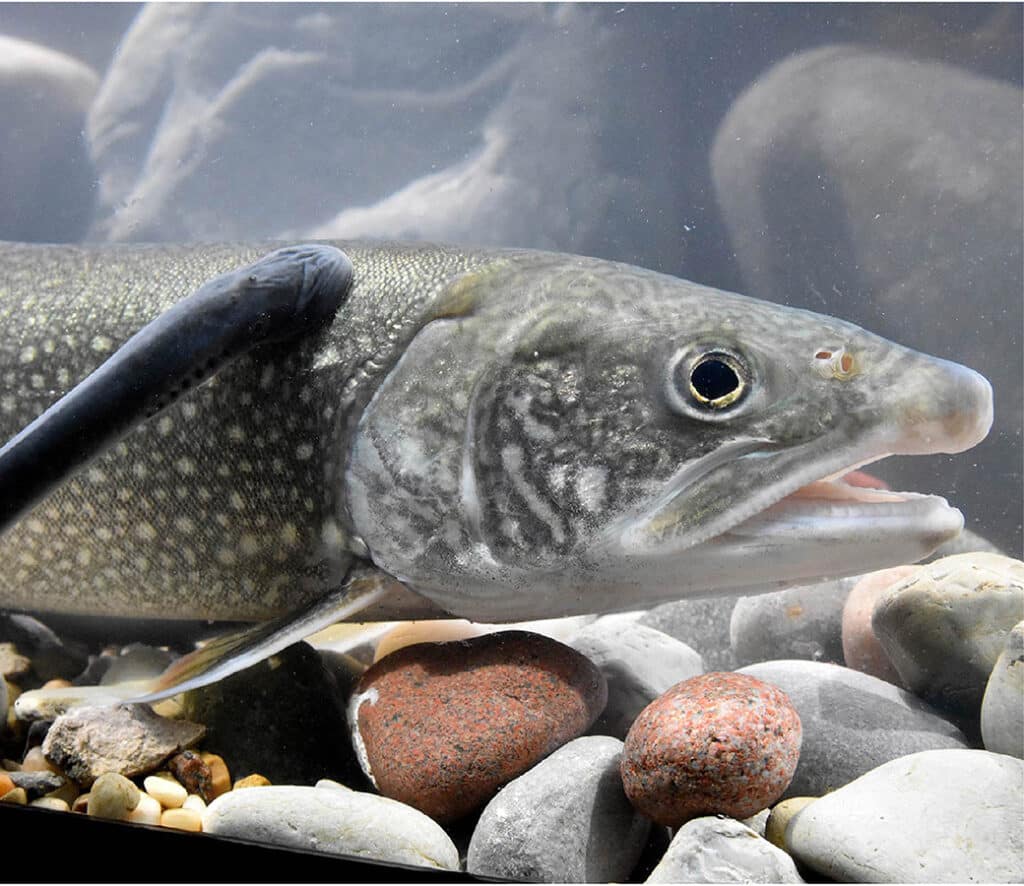
Researchers have announced that lake trout have fully recovered in most of Lake Superior. The Lake Superior Committee (LSC), which manages and protects the lake, credits this recovery to decades of sound research and conservation practices. However, they caution that, given climate predictions, species management must remain proactive and vigilant.
Superior’s largest predator
The lake trout, Lake Superior’s largest native predator, has returned to normal populations. It is a unique species with four ecological variants: lean, siscowet, humper, and redfin. As a coldwater fish, it inhabits coastal shorelines at depths between 65 and 260 feet and thrives in water temperatures below 50 degrees. Its diet includes smelt, cisco, burbot, and whitefish, shifting to larger prey as it grows. By the time it’s an adult, it weighs around 40 pounds.
Species nearly wiped out
Throughout the first half of the 20th century, overharvesting and the invasion of the sea lamprey caused a severe decline in trout populations, nearly leading to their collapse. In response, Canada and the United States established the Great Lakes Fishery Commission (GLFC) as a joint effort. This collaboration led to a multi-jurisdictional response to research, stock fish, share resources, and develop a recovery plan for the fisheries and invasive species. Under their direction, the Lake Superior Committee was created.
Initial efforts included applying targeted lampricides to reduce sea lamprey populations. Before action was taken, this invasive species numbered around 780,000 in the lake.
The production and stocking of hatchery lake trout, along with the development of fishing regulations, also contributed to their success. The commission established no-harvest zones that remain intact today. Consequently, stocking hatchery fish has nearly ceased, while lamprey suppression continues. In other areas of northern Minnesota, such as the Boundary Waters Canoe Area Wilderness, the Minnesota DNR has discontinued stocking trout.

Steady recovery
The presence of a healthy natural ecosystem has played a crucial role in maintaining their recovery. Lake trout are highly adaptable in their diet. As opportunistic feeders, they have utilized available food sources throughout all lake habitats. Historically, they ate coregonines (whitefish) and sculpins. With their return to sustainable numbers, their prey now includes smelt, ciscos, burbot, snakes, and birds.
Another factor in their recovery is the availability of their spawning habitats, which have remained intact for decades. Their preferred spawning habitat consists of coarse gravel intermixed with cobble, in areas free of fine sediment or organic material. Additionally, their wild spawning habitat is not only located near shorelines but also in offshore areas such as Isle Royale. Spawning occurs between October and November, and survey data shows that their reproductive biology has remained stable.
Finally, as the coldest of the Great Lakes, its frigid waters are typically resistant to changing conditions and invasive species.
Ongoing conservation efforts
Lake trout habitat and native prey populations have remained relatively intact, allowing for quick recovery. Much of this success is because previous generations of management developed strategies to guide rehabilitation. In an article by the North American Journal of Fisheries Management, the authors state, “Research studies since 1995 have provided significant advances in our knowledge of the ecology, genetics, and population dynamics of lake trout, which have improved stock assessments and fisheries management.”

Conservationists see it as one of the most successful recoveries of native species anywhere. Bill Mattes, LSC Chair, said, “This is an incredible success story made possible by widespread collaboration and coordination of tribal, state, and federal governments engaged in fisheries research, monitoring, and management. I look forward to the continued cooperation among fisheries managers and agencies to maintain healthy, self-sustaining lake trout populations in Lake Superior through effective sea lamprey control, prudent harvest policies, and protection of the Lake Superior ecosystem, which includes prevention of invasive species and water quality protection.”
Because of these efforts, increasing evidence suggests that the trout can remain resilient if effective management and responsible fishing practices are upheld.
More info:
- Lake Superior Committee announces major fishery management milestone: Lake Trout population is fully restored – Great Lakes Fishery Commission
- Synthesis of recent research and attributes of recovered lean Lake Trout populations in Lake Superior – North American Journal of Fisheries Management
- Lake Trout – Minnesota DNR


Wilderness guide and outdoorswoman Pam Wright has been exploring wild places since her youth. Remaining curious, she has navigated remote lakes in Canada by canoe, backpacked some of the highest mountains in the Sierra Nevada, and completed a thru-hike of the Superior Hiking Trail. Her professional roles include working as a wilderness guide in northern Minnesota and providing online education for outdoor enthusiasts.

